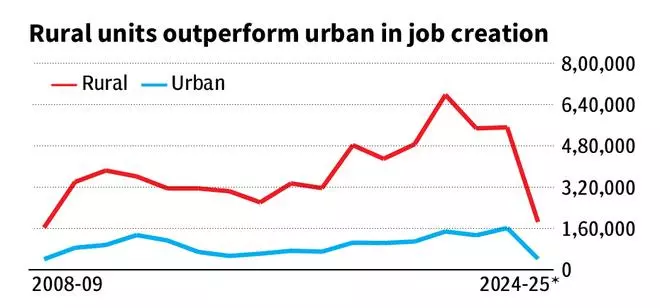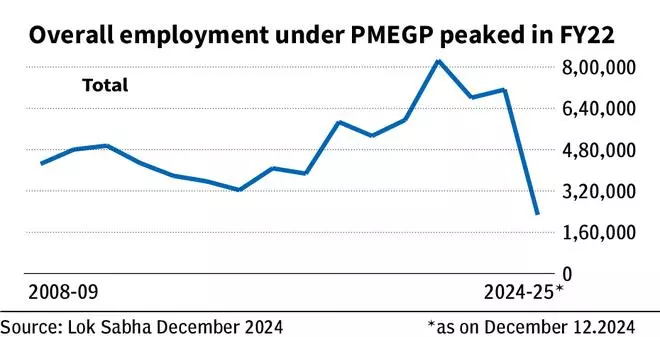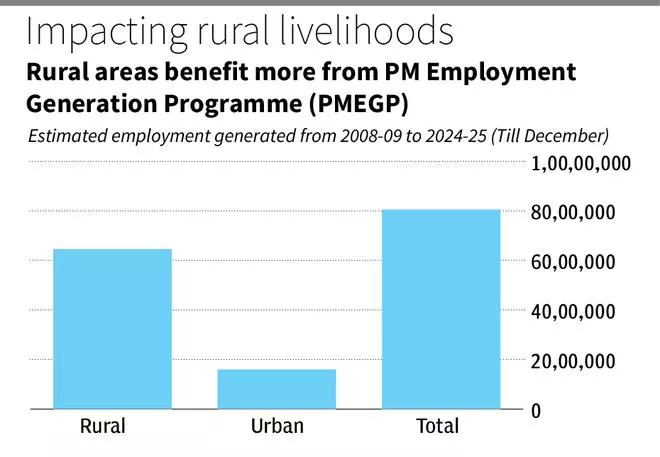In a significant trend over the last sixteen years, rural enterprises supported under the Prime Minister’s Employment Generation Programme (PMEGP) have outperformed their urban counterparts in generating employment. Micro enterprises established in rural areas across India have created an estimated 8.19 jobs per unit, surpassing the 8.07 jobs per unit generated by urban enterprises

Of the total 80.52 lakh estimated jobs created under PMEGP during this period, a substantial 64.55 lakh jobs were generated in rural areas. This highlights the programme’s greater impact on rural livelihoods. The Ministry of Micro, Small and Medium Enterprises (MSME), through the Khadi and Village Industries Commission (KVIC), has been implementing PMEGP to assist entrepreneurs in setting up new micro enterprises in the non-farm sector.
Out of the total 9.86 lakh units assisted, 79.89 per cent were in rural areas, while only 20.11 per cent were in urban areas. The Compound Annual Growth Rate (CAGR) for employment generated from 2008-09 to 2023-24 stands at an impressive 8.67 per cent across all units.
Covid Impact
The highest rural employment figures were recorded in 2021-22, with 6.77 lakh jobs created in a single year. This period coincided with the Covid-19 pandemic, which saw a large-scale migration of people from urban to rural areas. As urban livelihoods were severely impacted, PMEGP played a crucial role in supporting rural populations with employment opportunities.

In contrast, the highest urban employment generation under PMEGP was recorded in 2023-24, with 1.61 lakh jobs created. This indicates a gradual recovery and resurgence of urban enterprises post-pandemic.

The primary objectives of PMEGP include generating employment opportunities in both rural and urban areas by creating new self-employment ventures and micro enterprises. The programme aims to bring together traditional artisans and unemployed youth from rural and urban areas, providing them with self-employment opportunities at their residence.
Fund Aallocation
General category beneficiaries can avail a subsidy of 25 per cent of the project cost in rural areas and 15 per cent in urban areas. For beneficiaries from special categories, the subsidy rises to 35 per cent in rural areas and 25 per cent in urban areas. The maximum project cost allowed is ₹50 lakh for the manufacturing sector and ₹20 lakh for the service sector.
Since 2018-19, existing PMEGP/MUDRA enterprises have also been supported based on past good performances with a second loan for upgradation and expansion. Under the second loan, the maximum project cost admissible for Margin Money (MM) subsidy under the manufacturing sector is ₹1 crore and 25 lakh for service sector.
The eligible subsidy on the second loan for all categories is 15 per cent of the project cost (20 per cent for NER and hilly areas). PMEGP, being a Central sector scheme, no State-wise allocation of budget is done. Funds are utilised based on the demand generated and loans sanctioned by the financial institutions. An outlay of ₹13,554.42 crore has been approved for PMEGP for five financial years (2021-22 to 2025-26).








Leave a Comment